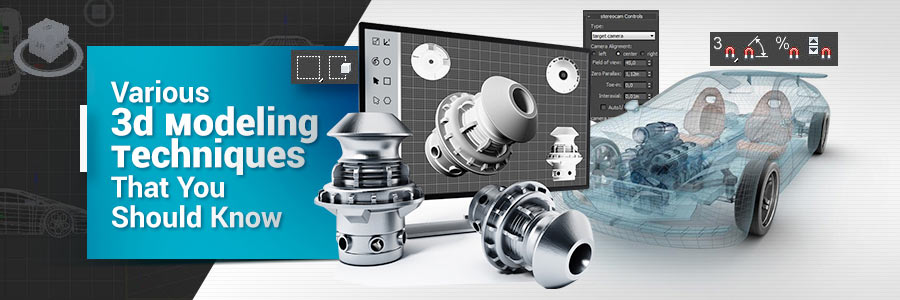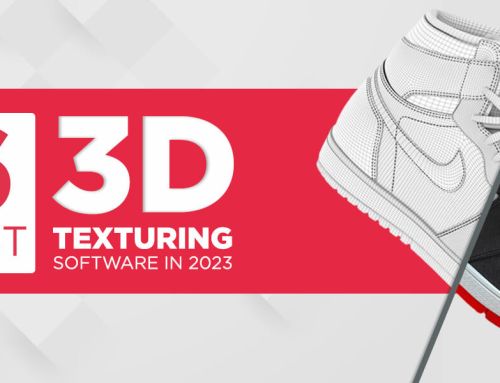Have you ever thought about how interior designers might create realistic 3D images of a building or area that hasn’t been built yet?
All of this is made possible by 3D modeling!
This blog post discusses the various types of 3D modelling techniques and where they are used. We’ll also take a look at the future of this exciting industry and how it might affect you!

Types of 3d modeling techniques
Different Types of 3D Modeling Techniques
Different techniques of 3D modeling enable us to design a variety of objects, some better than others. Continue reading to find out which form of 3D design is ideal for you!
It is the most basic form of 3D modeling. It is termed primitive because it is a fundamental style of 3D modeling that is mainly generated by combining several pre-existing forms. It involves building basic geometric shapes, cubes, spheres, etc.
- Pros: Simple and undemanding on computer, easy to adapt, create, & resemble the subject/s, helps in adding details.
- Cons: Not suitable for advanced designs, difficult to achieve high realism while creating organic shapes.
Surface Modeling
Surface Modeling is a computer-aided design that takes shape and curvature into account by depending on guiding lines. It’s more complex than other models, but it can create very detailed results.
Most commonly used for aerodynamic and thermodynamic designs, this technique under 3D modeling gives smooth transition from one to other vertex and also best for seam integration of edges.
- Pros: Allows complex designs or surfaces to be created at ease, helps in creating designs where aesthetics are important.
- Cons: Steep learning curve and extensive knowledge required, requires high computational power and arsenal.
Solid Modeling
Solid modeling is all about creating complex shapes and manipulating them to look the way you want. It’s a 3D modeling type that is used for sculpting.
This technique basically works with three-dimensional shapes such as spheres, cubes etc. that represents the object in 3D digital way and includes refined and detailed geometry within.
No matter whatever the procedure is, these solid models are created out of the primitive shapes like spheres, sub edges etc. but these are a creation of a whole design rather than being hollow; this is why the word ‘solid’ is used for them.
- Pros: It helps in creating a mathematically correct design, comes with user-friendly tools that are easy to use and learn, modeling tools and graphics are created at ease.
- Cons: Difficult to achieve high realism in organic designs and shapes.
Polygon Modeling
With polygonal 3D modelling type, designers can create intricate shapes and surfaces using X-Y coordinates to define different parts. They then combine these various pieces into one giant model or shape before being rendered out as pictures on a screen.
Also known by the name polyhedral modeling, this technique is most commonly used in the film and entertainment industry, gaming and animation sectors.
- Pros: These are efficient and easy to render, always creates uniqueness in the designs, designs can be animated and deformed at ease.
- Cons: Designs lack accuracy and geometrical errors are found commonly, not compatible with all types of resolutions, a time taking process mainly for complex designs.
NURBS Modeling
This is one of the most advanced forms of 3D modeling because it can create very complex shapes. The name stands for Non-Uniform Rational B-Splines (NURBS), which are very smooth curves used to create surfaces.
This modeling process mainly depends on the software for real to life design with a minimum or no human intervention.
- Pros: Gives the exact representation of the object, various types of organic shapes and curves can be created at ease, and creates designs for various advanced industries.
- Cons: Does not create a three- or five-sided patch, there are some texture limitations.
CAD Modeling
CAD stands for Computer Aided Design, and it’s another very advanced 3D designing technique. CAD is similar to solid modeling, but it’s more precise and can use more complex shapes.
- Pros: It is a streamlined designing process, automatically generates multiple documents, software and design flexibility.
- Cons: Consumes large amount of computer processing power, software complexity.
Wireframe Modeling
Wireframe modeling is another form of 3D design that creates the mesh in the picture. This 3D modeling type uses lines to create objects, but they aren’t filled in. This lets designers see how the model is shaped without adding any detail.
- Pros: Complex surfaces and curves can be created at ease, helps in creating solid models at ease, intersection of surfaces are not visible in the final design.
- Cons: Requires proper training, requires more polygons for rendering high quality models.
So, these are some of the most common types of 3D modeling you should be aware of. If you need a 3D model to be made, there are two ways of accomplishing this task. You can use 3D model software or outsource the project to a knowledgeable 3D modeling services company.
Download this article in PDF format.
Conclusion
3D technology is spreading throughout the world of design and is becoming more accessible than ever. So, get ready to see what this technology has in store for you. If you’re interested in learning some techniques to create 3D models yourself, there are many 3d design apps and software tools you can try!
Do you want to convert your ideas into 3D models?





